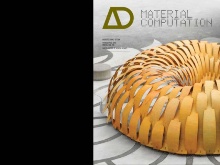Menges, A. (ed.): 2012, Material Computation – Higher Integration in Morphogenetic Design, Architectural Design, Vol. 82 No. 2, Wiley Academy, London. (ISBN: 978 0470973301)
The production of architecture, both intellectually and physically, is on the brink of a fundamental change. Computational design enables architects to integrate ever more multifaceted and complex design information, while the industrial logics of conventional building construction are eroding rapidly in a context of increasingly ubiquitous computer-controlled manufacturing and fabrication. A novel convergence of computation and materialisation is about to emerge, bringing the virtual process of design and the physical realisation of architecture much closer together, more so than ever before. Computation provides a powerful agency for both informing the design process through specific material behaviour and characteristics, and in turn informing the organisation of matter and material across multiple scales based on feedback from the environment. Computational design and integrated materialisation processes allow for uncovering the inherent morphogenetic potential of materials and thus are opening up a largely uncharted field of possibilities for the way the built environment in the 21st century is conceived and produced. In order to effectively introduce and outline the enabling power of computational design along with its inherent relationship to a biological paradigm, this publication looks at formation and materialisation in nature, integrative computational design, and engineering and manufacturing integration.


